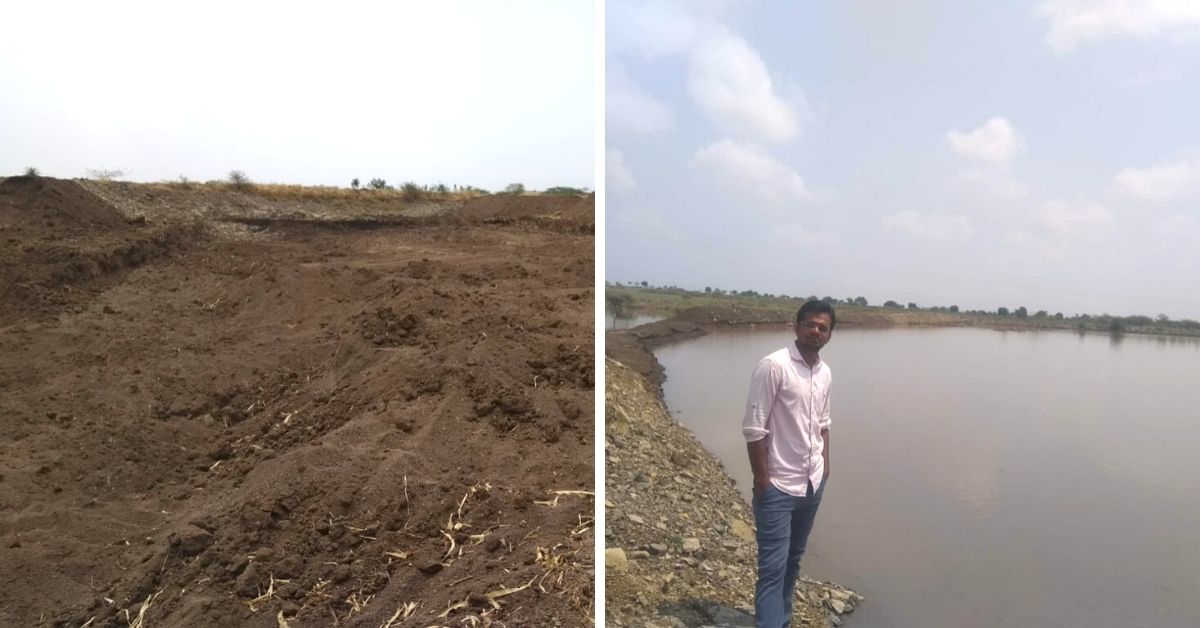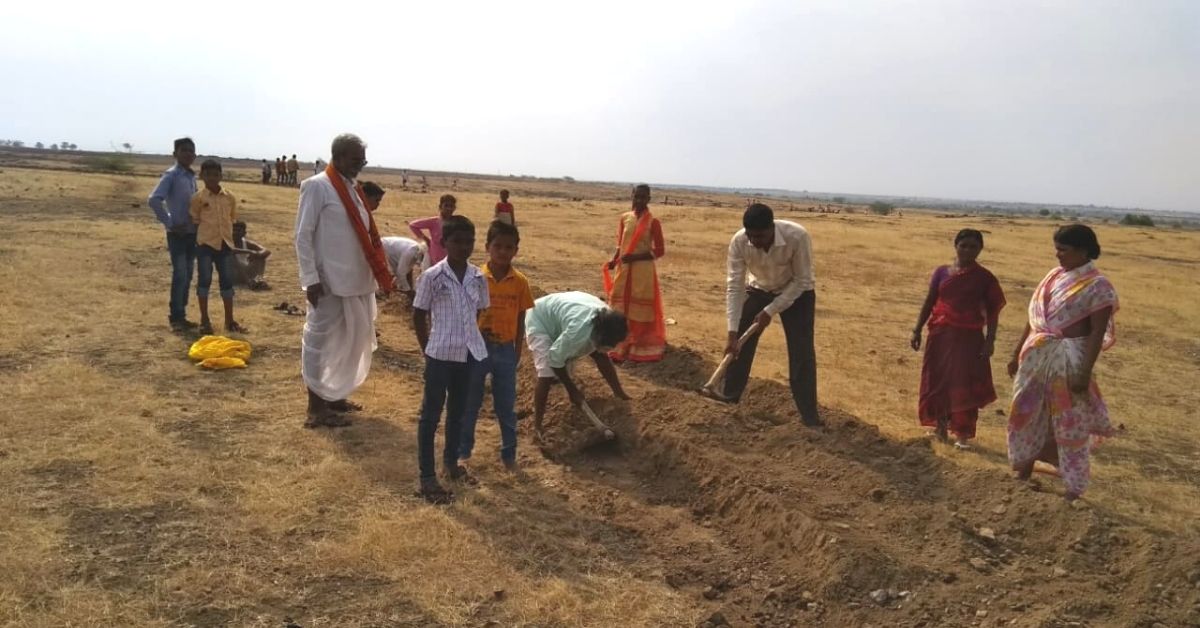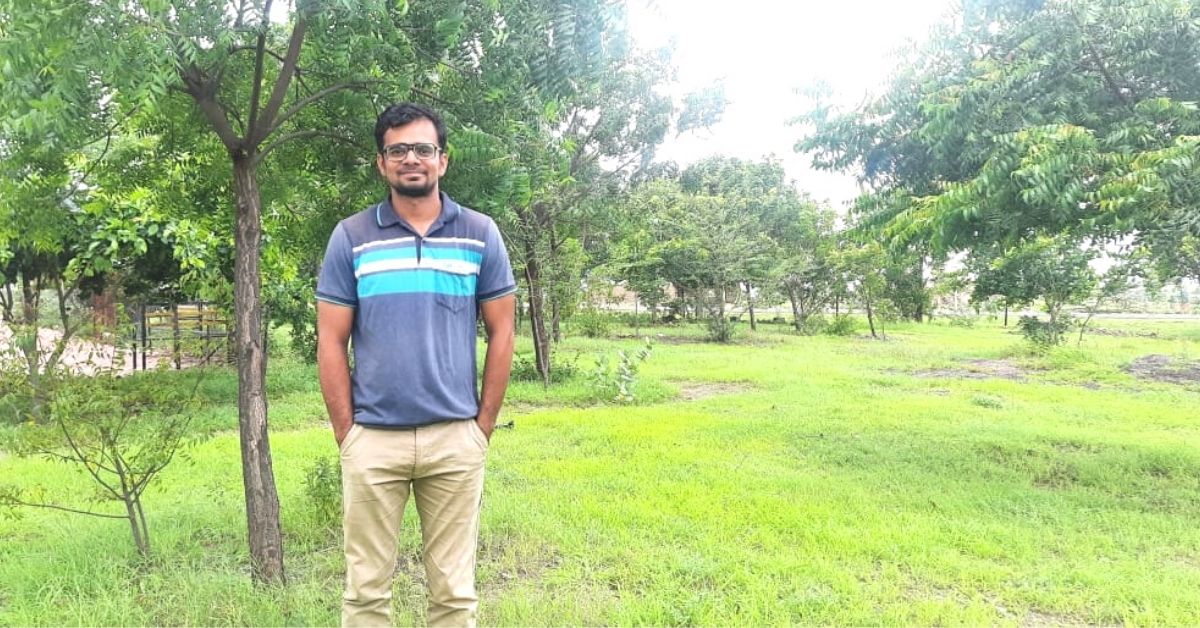Teacher Inspires Planting of 25,000 Trees, Community Saves 23 Crore Litres of Water
Bhaktaraj Garje came to Kulalwadi village of Sangli district in Maharashtra as a primary school teacher but he became a hero helping to double villagers' income and amplifying water conservation

In 2010, Bhaktaraj Garje, a native of Ahmednagar in Maharashtra, moved to Kulalwadi in Sangli district to take up a job as a primary school teacher. But his enthusiasm for his first job and motive to groom the future generations soon waned out.
There were two dilapidated classrooms and 97 students with a decreasing interest in academics, as they hardly attended school. “They remained absent for 6-8 months in a year, and it became difficult to follow up with the lessons and complete the syllabus on time,” he tells The Better India.
Despite his efforts to urge the students with innovative teaching methods, their attendance remained low.
Little did he know that the answer to his problem lay in planting trees and harvesting water.
Reconnecting with nature

When he dived deeper into his quest, Bhaktaraj realised that it was the water scarcity and migrant worker parents of students that hampered the education of his students.
However, over the past decade, he has taken concerted efforts to unshackle the villagers from the bonds of drought by conserving crores of litres of water every year and boost agriculture production to bring prosperity to the village.
“The region falls in the rain shadow region and receives about 300 mm of annual rainfall. The water shortage compelled the villagers to migrate with children and work as farm labourers in other parts of the state for their survival,” the 33-year-old says.
With only eight trees on the school premises in 2011, Bhaktaraj started planting saplings on the campus. He also taught his students the importance of trees in the environment and encouraged them to follow the practice at school and home.
“We planted 1,000 trees until 2016. A major boost came when the Paani Foundation, an initiative of Bollywood actor Aamir Khan, announced the ‘water cup competition’ to encourage water conservation in the village. I then urged the villagers to participate in the same. The members of the foundation explained the guidelines and conducted workshops,” he says.
Bhaktaraj says that some villagers became convinced and decided to support him. “Villagers started contributing money and slowly started volunteering by digging trenches, building boulders, small check dams and other water conservation structures to arrest rainwater,” he adds.
The villagers completed work to store 2.3 lakh cubic meters equivalent to 23 crore litres of water. “One bout of rain could save and percolate crores of litres of water. We also planted an additional 3,500 trees in barren land around the village,” he says.

Bhaktaraj says the villagers spent the next three years protecting the plants, ensuring their survival. “The land is rocky, and to ensure that water seeps in, we put sand in the pipe along with the roots and allow efficient watering of the plants. Agriculture techniques like the use of dry leaves and agriculture waste were laid as mulching and prevented water evaporation,” he explains.
The villagers also used organic fertilisers like the jeevamrut, a mixture made from gram flour, cow dung, cow urine, jaggery and water that helps increase the microbial activity and nutritional value in the soil.
Bhaktaraj says as the news about his conservation efforts spread to international waters, and some donors from the USA and the UK donated Rs 3 lakh for the cause. “The villagers contributed from Rs 200 to Rs 1,000, and the total amount came close to Rs 10 lakh. In 2018 and 2019, the village won Rs 8 lakh in terms of awards from the Paani Foundation. The residents invested the prize money to carry out the water conservation works that have now transformed the village,” he says.
Looking at their success, the forest department also planted one lakh saplings around 190 hectares. An additional 20,000 saplings of fruit-bearing trees were planted in the common land of 22 hectares by the social forestry department. A local NGO Youth for Jath also extended support to build farm ponds for the village.
Bhaktaraj says the overall conservation efforts for tree plantation and water harvesting has brought greenery to the once dry and barren village. “There was a time when the villagers couldn’t practice agriculture. Today, the village has 25,000 fruit-bearing trees in 500 orchards,” he adds.
The migration of the villagers for work has reduced by 20 per cent, and the number of students attending school has increased to 245. “The two classrooms started falling short of space, and now we have eight more with other infrastructure facilities like a playground. The number of teachers has increased from two to nine,” he says.
Mohan Guldagad, a farmer with a 5-acre land, says, “Bhaktaraj came as a blessing to the village. The residents didn’t know the importance of plants or water conservation. On the contrary, the locals grazed their cattle on the saplings, vegetation or uprooted them. The teacher took immense efforts to educate the villagers.” He adds that the farmers undertake the harvesting of two crops a year now and practice horticulture too.
He adds that the mindset of the villagers have changed to the extent that they take additional efforts to protect and water the new plantations. “The locals have developed a connection towards the environment,” he says.
He further adds that the groundwater levels that were once depleted up to 400 feet have increased to 40 feet. “The villagers were tired of irregular supply of water and to rely on tankers. They entered into conflicts for water. However, the wells are filled up to the brim this season. The surplus water availability has put an end to all our woes and benefited every village,” Mohan says.
Budgeting Water

Speaking of the challenges of his feat, Bhaktaraj says, “The residents are mainly uneducated, and explaining to them the benefits of the environment and its role for human survival was a challenge. Hence, I focussed more on students, teaching them through drawings and other interactive content. The workshops helped to give confidence to the villagers.”
The village is now moving towards water budgeting and has now shifted focus to organic farming. “We are drawing up a plan where the villagers will take up crops, depending on the amount of rainfall received in a particular year and the water availability. The water budgeting will help to prevent exploitation of surface and groundwater without affecting the livelihood of people,” he says.
On a parting note, Bhaktaraj says that no village should wait for outside support to overcome its problems. “The villagers united and contributed to help themselves. Water conservation is not rocket science but traditional knowledge executed scientifically. So, it is only through sheer willpower and dedicated efforts that can help any village to overcome the water crisis.”
Edited by Yoshita Rao
If you found our stories insightful, informative, or even just enjoyable, we invite you to consider making a voluntary payment to support the work we do at The Better India. Your contribution helps us continue producing quality content that educates, inspires, and drives positive change.
Choose one of the payment options below for your contribution-
By paying for the stories you value, you directly contribute to sustaining our efforts focused on making a difference in the world. Together, let's ensure that impactful stories continue to be told and shared, enriching lives and communities alike.
Thank you for your support. Here are some frequently asked questions you might find helpful to know why you are contributing?


This story made me
-
97
-
121
-
89
-
167














